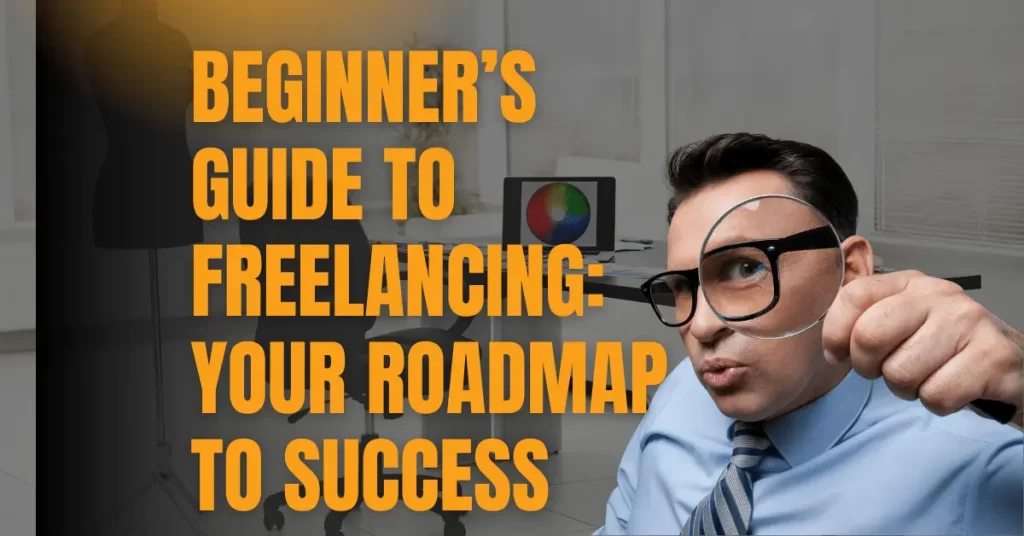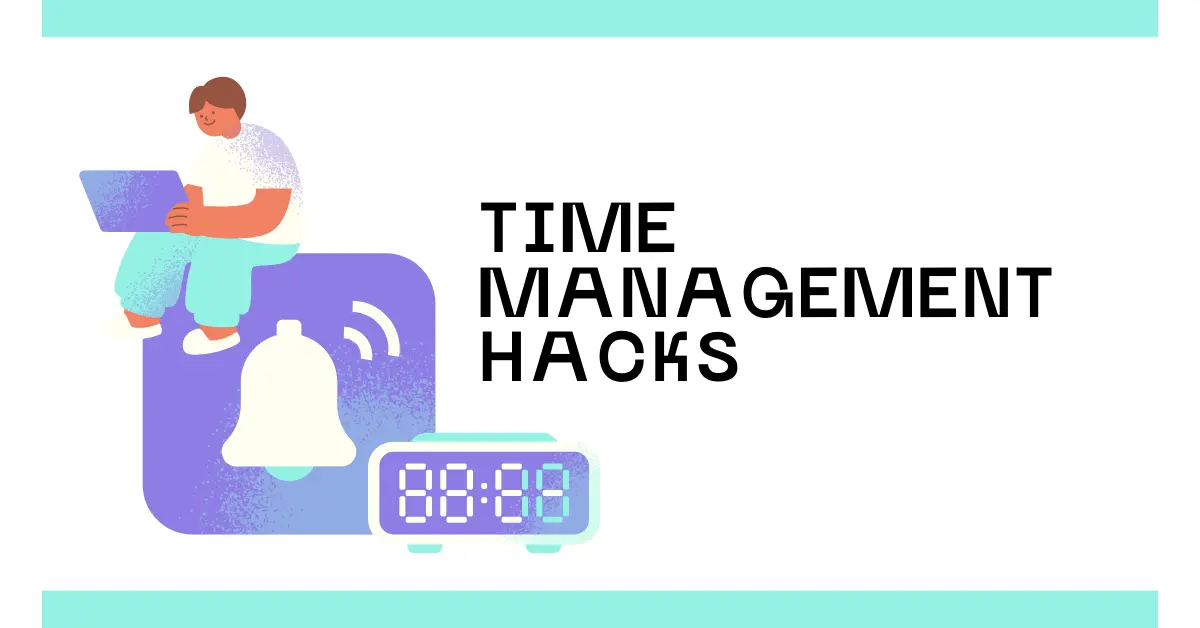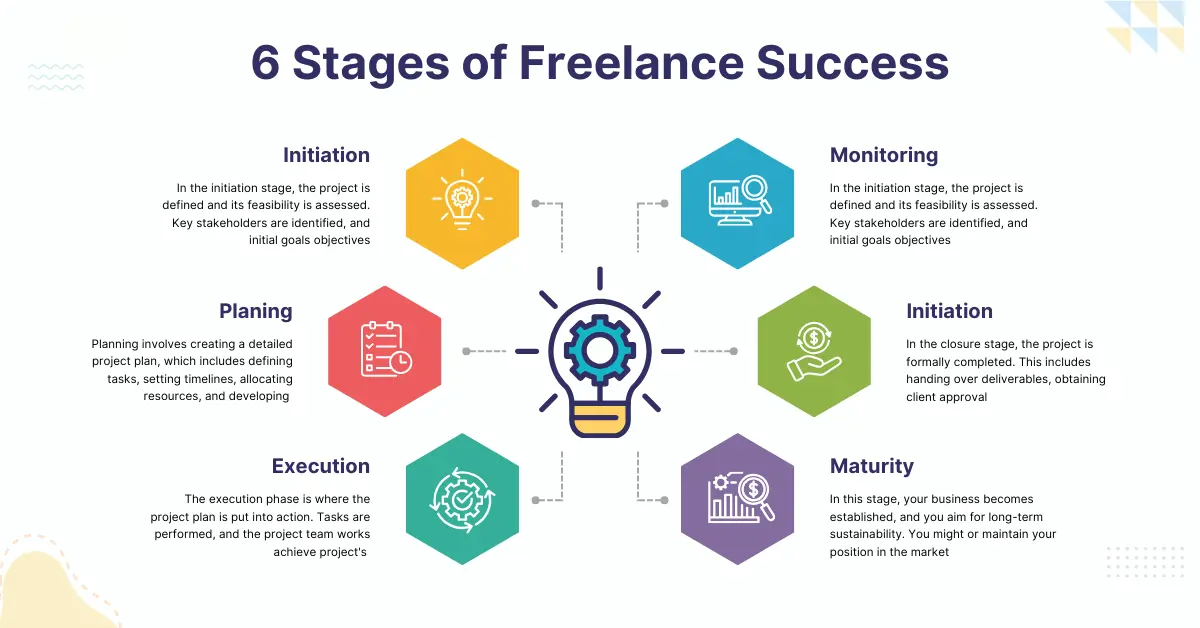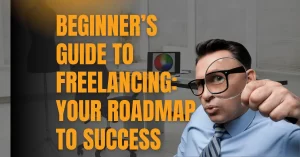The Ultimate Beginner’s Guide to Freelancing: Start Your Journey Today!
Sahil Amin October 16, 2024 0
Introduction:
I was lured to freelance work since it offered freedom from workplace politics and strict timetables when I initially started. In the internet age, freelancing has changed dramatically and become more accessible to millions of people worldwide. Freelancing is a great job choice if you’re searching for flexibility, autonomy, or a way to increase your income. The finest aspect? It has low entrance barriers, is ideal for beginners, and offers lots of chances to learn as you make money. We’ll lead you through a clear road map in this Beginner’s Guide to Freelancing to help you get started and position yourself for long-term success.
What is Freelancing?: Beginner’s Guide to Freelancing
As a freelancer, I am not restricted to working for a single company and may provide my abilities and services to clients directly. It all comes down to flexibility: I get to pick the tasks I want to complete, establish my own schedule, and even determine how much to bill for my services. Freelancing provides up a universe of possibilities, no matter my interests in content writing, web development, graphic design, digital marketing, or consulting.
Working with numerous clients at once is one of the main advantages of freelancing. As a result, I can diversify my sources of income and am not dependent on any one company. It’s a fantastic approach to develop a profession that fits my lifestyle and personal objectives.
You will learn how freelancing allows you to work on your own terms and develop your abilities in a variety of industries if you read our Beginner’s Guide to Freelancing. There are lots of options, and if you take the proper steps, you can make freelancing a successful and rewarding profession.
Assessing Your Skills
Evaluating my current skill set and identifying the marketable ones is essential when venturing into freelance work. I put equal emphasis on my hard skills—such as technical proficiency—and soft skills—such as problem-solving and communication. This assists me in determining what I can provide to clients from the outset.
The development of skills is essential for those of us who are new to freelancing. Through online classes, certifications, or even side projects, I can improve my skills. Through constant learning and development, I raise my chances of success in the cutthroat world of freelance work.
Anyone using a Beginner’s Guide to Freelancing must go through this procedure in order to provide a strong basis for long-term success.
Choosing Your Freelance Niche
Why Niching Down Matters:
I’ve learned that narrowing down is essential for standing out in a crowded market as I start my freelance career. I stress in this Beginner’s Guide to Freelancing that having a specialization helps me establish myself as an authority and makes it simpler for potential clients to find and select me. When I concentrate on a certain subject, I not only improve my abilities but also establish a name that draws customers in need of specialized services.
How to Choose a Niche:
My decision to specialize sets me apart from the masses. It distinguishes myself from the competition, much like a USP. Working with freelancers with specialized knowledge is frequently preferred by clients over generalists. As I make clear in my Beginner’s Guide to Freelancing, a focused strategy like this enables me to charge better rates and build lasting connections with clients—two things that are crucial for success in the freelance world.
Nich Research:
I consider market demand as well as my interests and talents while choosing the ideal niche. These are the procedures I use:
Determine Your Skills: I assess my strengths. Identifying my areas of strength in writing, design, and digital marketing allows me to focus more intently.
Examine My Passions: I think about the things I like to do. My drive and level of engagement at work are sustained by passion.
Conducting Market Demand Research: I investigate the services that are in high demand. For example, I’ve discovered that e-commerce SEO, mobile app development, and technical writing are all growing niches.
Building Your Portfolio
Why a Portfolio is Crucial:
A solid portfolio, in my opinion, is a must for every freelancer. It presents my work and draws in future customers by serving as social proof. It’s easier for clients to trust me when I can showcase my abilities and the caliber of my services through my portfolio.
Creating a Strong Portfolio Without Experience:
Upon commencing my freelance career, I lacked much experience. I gave friends and nearby businesses free or heavily reduced work in order to expand my portfolio. With the help of this tactic, I was able to produce works that I was glad to present and acquire useful experience. In order to further showcase my abilities, I also started side projects that matched my interests and aptitudes.
Essential Elements of a Portfolio:
A solid portfolio needs to have a number of essential components. I first concentrate on in-depth case studies that describe the difficulties, my strategy, and the outcomes I was able to attain. Additionally, I collect endorsements from contented customers, as their remarks give my job legitimacy. Additionally important are visual samples, particularly for initiatives including design. I make sure to present my best work in an eye-catching manner so prospective clients may see my creative abilities.


Finding Freelance Jobs
Where to Find Freelance Opportunities
Popular Freelance Marketplaces:
Upwork, Fiverr, and Freelancer.com are some of the ones I frequently use. These websites are gold mines of job postings that let me meet clients and present my qualifications. Niche sites like 99designs for design work or Toptal for computer workers can be immensely helpful for those of us in particular industries.
Job Boards for Freelancers:
Freelancer Job sites: I’ve had a lot of luck with freelancer-focused job sites like ProBlogger, We Work Remotely, and FlexJobs. I may find employment that match my skill set thanks to the frequent postings of remote and freelancing possibilities on these sites.
Cold Reach and Networking:
I use internet groups, LinkedIn, and trade forums to establish natural connections with prospective customers. I’ve been able to build relationships through networking and direct communication that frequently result in new freelance possibilities.
Creating a Standout Freelance Profile
Optimizing Your Freelance Profile
I Compose a Simple, Interesting Bio:
I try to capture my personality and enthusiasm for my job in my bio. This facilitates a more personal connection between me and future clients.
I Emphasize My Areas of Expertise and Skill Set:
I make a point of highlighting my areas of expertise and skill set. Clients can see exactly what I bring to the table thanks to this.
I Provide Testimonials and Portfolio Links:
I provide references to my finest work as well as words of wisdom from pleased customers. This increases confidence and validates my ability.
Selecting the Right Projects:
I usually try to strike a balance between beginning ventures that pay little and those that provide important experience. I can progressively raise my earning potential while improving my talents by selecting tasks carefully.
Applying for Freelance Jobs
How to Write Winning Proposals
My goal when applying for freelancing work is to create proposals that are compelling and memorable to potential clients. This is how I go about it:
I Adapt Each Proposal to the Requirements of the Client:
I take the time to fully comprehend each project’s unique requirements before tailoring my proposal to specifically meet those demands.
I Present My Unique Value Proposition:
I make clear what makes me stand apart from other independent contractors by showcasing my qualifications and experience, which position me as the ideal candidate.
I Clearly Organize My Proposal:
I provide my proposals in an organized manner, along with a thorough project schedule and milestones. Clients gain confidence in my talents and are better able to grasp what to expect thanks to this clarity.
How to Handle Rejection
Being turned down is a part of the freelance path, but I keep motivated by seeing it as a chance to improve. These are my suggestions for recovering:
I Consider My Suggestions: I assess what could have gone wrong with a rejection and improve my strategy for subsequent applications.
I Remind Myself That Every Freelancer Faces Rejection, and I Continue Applying for Jobs, Using Every Experience to Improve My Proposals. This helps Me Remain Positive and Persistent.


Setting Your Freelance Rates
Determining the Cost of Your Freelance Work
It was difficult for me to determine how much to charge for my services when I first started freelancing. I’ve detailed my steps for navigating this procedure in my Beginner’s Guide to Freelancing.
Recognizing Market Prices
I looked into what other independent contractors in my field were charging on Fiverr and Upwork. I was able to comprehend the market and establish a competitive position because to this.
Important Things to Take Into Account
My price plan was influenced by several important factors:
Experience Level:
I started off charging less to draw clients, but as my portfolio and skills improved, I increased my charges.
Project difficulty:
I determined the right prices by evaluating the difficulty of each project, making sure to charge extra for specialist work.
Time Commitment:
To make sure my pricing reflected the effort required, I estimated how long each project would take.
Establishing a Baseline
It was crucial to determine a minimum rate depending on my financial requirements. By calculating the amount of money, I needed to support my freelance work, I was able to decline tasks that didn’t fit this budget with confidence.
I firmly set my freelance prices by using these procedures. I hope my Beginner’s Guide to Freelancing’s insights will be useful to you as you go through your own pricing process!
Hourly vs. Project-Based Pricing
I evaluate the characteristics of each assignment when deciding whether to charge by the hour or by the project.
When to Charge Hourly:
For short-term projects or ones where the scope is still unknown, I usually charge hourly rates. I can now adjust to changes without feeling constrained by a set cost thanks to this. I can better appraise a problem with an hourly rate if the client is unsure of what they require at this point.
When to Charge Per Project:
I prefer to charge per project for long-term engagements or well-defined projects with defined deliverables. This pricing structure helps to prevent any surprises later on by providing my client and myself with clear information about the entire cost.
Pros and Cons of Each Model:
Each pricing model has its advantages and drawbacks. Charging hourly offers flexibility and the potential for higher earnings on projects that take longer than expected. However, it can also lead to unpredictability in my income. On the other hand, project-based pricing provides stability and predictability for my clients and me, but it may limit my income if I underestimate the time required.
Negotiating with Clients
Although negotiating my prices can be difficult, I’ve developed useful strategies that enable me to uphold my worth.
Effective Negotiation Strategies:
I consistently defend my prices by citing my qualifications, expertise, and contribution to the project. I maintain my composure and am willing to work toward a compromise if clients object or bring up financial constraints. I have, however, also learnt to know when to turn down low-paying offers that don’t reflect my value.
Developing Long-Term Client Relationships:
I’ve discovered that clients that are prepared to commit to continuous work can be drawn in by providing value-based pricing. By showcasing my dedication to producing excellent outcomes, I can cultivate enduring partnerships that are advantageous to both of us. This strategy helps me build trust and dependability in my freelancing job in addition to helping me keep a steady income.
Managing Freelance Projects
Planning and Organizing Your Work
Time Management Tools:
Effective project management is essential to success as a freelancer. I’ll go over how I schedule and manage my freelancing work in this section so that you may remain on top of deadlines and get excellent outcomes.
Tools for Time Management
I use effective time management tools that keep me focused and organized in order to handle my task. Below are a few of my favorite tools:
Asana, Trello, or Notion are great tools for managing tasks. They help me divide my projects into more manageable chunks of work. I can keep a visual record of my progress and ensure that I’m continually making progress by making lists or boards. It is simpler to see what has to be done when each task has a clear subtask, priority level, and due date.
When charging by the hour, time monitoring software such as Toggl or Clockify becomes crucial for independent contractors. I keep track of how much time I spend on each task using apps like Clockify and Toggl. This not only guarantees that I get paid on time, but it also gives me insight into how my time is spent so that I can better for next jobs.


Setting Milestones and Deadlines:
The work feels less difficult when it is divided into more manageable, achievable tasks rather than one big project. Every step of the process has distinct deadlines and goals that I always establish. This is how I go about it:
Define the project scope: I make sure I grasp the project needs completely before starting. I then list the main things that need to be done to finish the project.
Divide work into milestones: I divide the jobs into milestones for larger projects. These are crucial junctures when I can assess my development and confirm that I’m on course. I can track my progress on the project and recognize tiny victories by doing this.
Establish deadlines for each milestone: I establish reasonable timelines for every milestone to make sure the project stays on track. Giving myself ample time to finish each activity at hand without hurrying helps me retain quality and reduce stress at the last minute.
My ability to maintain organization and timely completion of freelance jobs stems from my use of time management tools and the establishment of certain milestones. A successful independent profession requires careful planning and organization, especially in the beginning. A key component of becoming an expert freelancer is project management, which will help you advance your career by keeping you at the top of your game.
Client Communication
Understanding how to communicate with clients is crucial for freelancers. This is an essential guide for anyone following this Beginner’s Guide to Freelancing on how to manage client relationships and set clear expectations.
How I Clearly State My Expectations
Having clear expectations with my clients from the outset is crucial. This is my main focus:
Work Scope: I always ensure that my clients and I are in agreement over the specifics of the job. I provide a clear description of my work to ensure that everyone is aware of what is expected of them. Additionally, by doing this, I can prevent scope creep, which occurs when clients want more work without paying for it.
Deadlines: Keeping a professional connection alive requires punctuality. In addition to updating my clients on my progress, I talk with them on reasonable timelines that benefit us both.
Communication lines: I create explicit lines of communication right away. I communicate with my clients via email, Slack, or scheduled conversations, informing them of my best contact information and the frequency of updates.
These procedures help me to guarantee clear communication and minimize miscommunications, which is an essential component of any beginner’s guide to freelancing.
Best Practices for Managing Difficult Clients:
Even though I strive for easy sailing, challenging clients are unavoidable. Here’s how I successfully handle them:
Clearly Defined Boundaries: I started off with boundaries. I inform my clients of what to expect from me and when, whether it’s about project scope, working hours, or response times.
Engaging in Active Listening: I try to pay close attention to what my clients are saying. Most of the time, customers just want to feel heard, so before I answer, I make sure I know what worries them.
Resolution of Conflicts: When disputes emerge, I maintain composure and concentrate on finding answers. I listen to my clients’ worries, remind them of the original agreements, and we collaborate to create a middle ground. Maintaining the relationship means acting with professionalism and decency.
Delivering Quality Work
Meeting Deadlines Consistently
I don’t negotiate on meeting deadlines when I take on freelancing work. Setting priorities for my responsibilities has helped me keep on top of my job, I’ve discovered. I always begin by dividing up large projects into smaller ones and giving each one a reasonable deadline. I’ll be able to monitor my development and stay ahead of schedule this way. In order to maintain organization and make sure I’m never behind, I also use tools like task managers and calendars. I regularly fulfill deadlines by keeping a systematic workflow, which helps me gain my clients’ trust and expand my freelance business.
Ensuring Client Satisfaction:
Ensuring my clients are satisfied is just as important as completing the task at hand while producing high-quality work. Throughout a project, I keep in touch with clients to make sure I’m on schedule and meeting their expectations. I’m always willing to hear criticism and fast to make adjustments if necessary. Using this method not only helps me achieve the greatest outcomes, but it also improves my rapport with clients. In order to succeed as a freelancer for the long run, I want to go above and beyond for my clients.


Legal and Financial Aspects of Freelancing
Freelance Contracts
My experience as a freelancer has taught me how important it is to have a strong contract in place to safeguard my company. In order to guarantee that my clients and I are in agreement, contracts offer legal protection, establish the parameters of the job, and outline the terms of payment.
Important Components of a Freelance Agreement:
Deliverables: Clearly state what I will offer, including the project or certain services.
Timelines: To hold both parties accountable, set deadlines for project milestones.
Timetables for Payment: Indicate whether I will be paid in full, in installments, or at the end of the project.
Confidentiality agreements: safeguard private information shared during the project.
I suggest using contract templates from websites like PandaDoc or Rocket Lawyer to make the process simpler. These tools include editable templates that will enable me to preserve my professionalism and protect my work.
Managing Taxes as a Freelancer
Since I work for myself, handling my taxes is crucial. This is how I respond to it:
Recognizing Your Tax Duties
I keep a close eye on my earnings and outlays via accounting software or a spreadsheet. This routine helps me during tax season and gives me a clear picture of my earnings.
I also make use of the tax breaks offered to independent contractors, like:
Home Office Deduction: I am able to write off costs such as internet, utilities, and rent if I utilize a portion of my house for work.
Equipment & Supplies: In order to lower my taxable income, I save the receipts for purchases I make for my laptop, software, and other work-related expenses.
Using Accounting Software:
Making Use of Accounting Software
To make tax filing easier, I use accounting software like FreshBooks or QuickBooks. By automating expense monitoring and invoicing, these solutions save me time and lower error rates. They also keep an eye on my income all year long, which helps me get ready for my quarterly estimated tax payments.
Invoicing and Getting Paid
Best Practices for Invoicing:
I make sure my bills are professional and easy to understand. Here are a few essential components I mention:
Header: I begin by including my company name, logo, and contact details at the top. This makes my brand instantly identifiable.
Invoice Number: For ease of tracking, every invoice is assigned a unique number. I maintain a log of every invoice I issue.
Date: Both the invoice date and the payment deadline are included. This facilitates clients’ payment schedules.
Itemized List of Services: I list all the services I offered, together with their costs, descriptions, and number of hours spent. Customers benefit from knowing what they’re paying for thanks to this transparency.
Whole Amount owing: I make it simple for clients to understand their duty by plainly stating the whole amount owing at the bottom.
Payment Instructions: I give precise payment instructions that include my approved methods of payment and any other information that may be required, such as account numbers.
Following Up on Unpaid Invoices
Regretfully, late payments from clients do occur occasionally. In order to pursue outstanding debts, I undertake these procedures:
Kindly Reminder: A few days beyond the due date, I send a courteous email reminder if payment is past due. To be explicit, I make reference to the invoice number and the due date.
Second Follow-Up: After a week, if I still don’t hear back, I send out another email expressing empathy for any possible problems they might have had.
Direct Communication: I’m happy to speak with you over the phone or through messaging if we need to talk about the invoice in detail. Sometimes, this personal touch leads to faster payouts.
Gateways for payments
I employ a few trustworthy and user-friendly payment gateways to ensure a smooth payment transaction.
Here are a few that I suggest:
One of the most often used methods is PayPal, which lets users pay with a credit or debit card or their PayPal account. I value its familiarity with customers.
TransferWise (now Wise): I use TransferWise (now Wise) for overseas payments since it provides better exchange rates and less costs than traditional banks.
Stripe: I think Stripe’s connection with invoicing software is great. It is really convenient that customers can pay immediately through my website.
Marketing Yourself as a Freelancer
Building Your Personal Brand
Effective self-promotion is crucial as I start my freelance career. Here is a quick synopsis of my methodology:
Establishing My Own Brand
Personal branding: What is it?
My personal branding highlights my principles and skills, which helps me stand out in the freelancing market.
Establishing My Expert Status
In order to establish my authority, I write blog entries, produce instructional materials, and provide free resources.
Making Use of LinkedIn and Social Media
Social Media Techniques
I interact with potential clients directly on social media, participate in industry organizations, and publish insightful information.
Making My LinkedIn Profile Better
I make an impactful summary, write a captivating headline, and ask for recommendations and endorsements to maximize my LinkedIn profile.
Client Testimonials and Referrals
Customer References and Testimonials
How to Request References
After projects are finished, I ask happy clients for feedback, making sure my requests are genuine.
Using Testimonials Effectively: To gain the trust of prospective clients, I place a lot of testimonials on my website, in my portfolio, and in my proposals.
Creating a Network of Referrals
I keep up good ties with colleagues and clients, promoting word-of-mouth advertising and providing rewards for recommendations.
I’ll be able to successfully market myself as a freelancer and advance my career with the aid of this method.


Freelancing for the Long Term
Scaling your firm, increasing revenue diversity, and preserving a positive work-life balance are all essential to establishing a long-lasting freelancing job. Here is a brief synopsis of every facet:
Growing Your Services and Scaling Your Freelance Business
Offering more expensive services or consulting, in my experience, can greatly increase my revenue. I draw in more business and raise my total worth as I extend my service offering.
Employing Subcontractors
When I wish to take on larger projects, I have to outsource some work. I can ensure efficiency and quality while concentrating on the important parts of my business by using subcontractors.
Spreading Out Your Revenue
Establishing Sources of Passive Income
Through affiliate marketing, digital items, and online courses, I actively generate passive revenue. These sources give me extra money while I concentrate on working with clients.
Constructing a Long-Term Business Plan
In order to attain sustained stability, I consistently evaluate and modify my sources of income. With this calculated strategy, I am able to keep my revenue stream consistent.
Keeping a Healthy Work-Life Balance
Preventing Burnout
It is critical to identify indicators of burnout. I create boundaries for my work so I may safeguard my mental well-being and make sure I take breaks when needed.
Managing Freelance Work and Personal Life Harmonization
The secret to keeping balance is efficient time management. I stay productive and fulfilled by setting priorities for my tasks and making time for personal rest and rejuvenation.
FAQs
How can I balance multiple freelance projects without compromising quality?
Managing multiple clients requires using project management tools, setting clear boundaries, and prioritizing tasks based on deadlines and complexity. Time tracking and milestone setting can help maintain quality across all projects.What should I do if a client asks for work beyond the agreed scope?
This is known as “scope creep.” To handle it, politely remind the client of the original agreement, and discuss whether additional work can be done for an extra fee or in a separate project.How can I avoid burnout as a freelancer working from home?
Freelancers are prone to burnout due to the lack of separation between work and personal life. Setting strict work hours, taking regular breaks, and scheduling time for self-care can help maintain a healthy work-life balance.How do I handle inconsistent income as a freelancer?
Freelancers often face fluctuating income. You can mitigate this by setting aside emergency savings, diversifying your income streams (e.g., passive income or part-time projects), and building long-term client relationships for steady work.What are the most effective ways to market myself as a freelancer without a big budget?
Leverage free tools like social media, LinkedIn, and online communities. Sharing valuable content, engaging in relevant discussions, and networking with peers can increase your visibility without heavy spending on ads or marketing.






